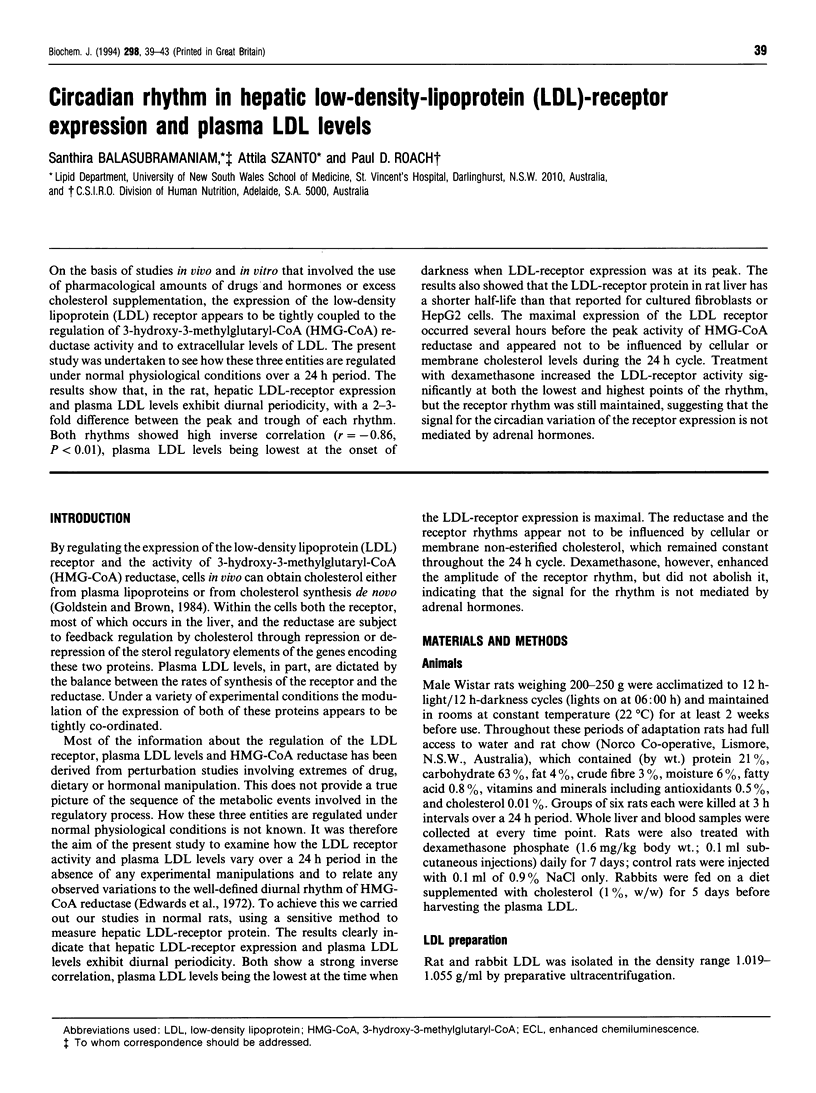Abstract
On the basis of studies in vivo and in vitro that involved the use of pharmacological amounts of drugs and hormones or excess cholesterol supplementation, the expression of the low-density lipoprotein (LDL) receptor appears to be tightly coupled to the regulation of 3-hydroxy-3-methylglutaryl-CoA (HMG-CoA) reductase activity and to extracellular levels of LDL. The present study was undertaken to see how these three entities are regulated under normal physiological conditions over a 24 h period. The results show that, in the rat, hepatic LDL-receptor expression and plasma LDL levels exhibit diurnal periodicity, with a 2-3-fold difference between the peak and trough of each rhythm. Both rhythms showed high inverse correlation (r = -0.86, P < 0.01), plasma LDL levels being lowest at the onset of darkness when LDL-receptor expression was at its peak. The results also showed that the LDL-receptor protein in rat liver has a shorter half-life than that reported for cultured fibroblasts or HepG2 cells. The maximal expression of the LDL receptor occurred several hours before the peak activity of HMG-CoA reductase and appeared not to be influenced by cellular or membrane cholesterol levels during the 24 h cycle. Treatment with dexamethasone increased the LDL-receptor activity significantly at both the lowest and highest points of the rhythm, but the receptor rhythm was still maintained, suggesting that the signal for the circadian variation of the receptor expression is not mediated by adrenal hormones.
Full text
PDF




Images in this article
Selected References
These references are in PubMed. This may not be the complete list of references from this article.
- Balasubramaniam S., Goldstein J. L., Faust J. R., Brown M. S. Evidence for regulation of 3-hydroxy-3-methylglutaryl coenzyme A reductase activity and cholesterol synthesis in nonhepatic tissues of rat. Proc Natl Acad Sci U S A. 1976 Aug;73(8):2564–2568. doi: 10.1073/pnas.73.8.2564. [DOI] [PMC free article] [PubMed] [Google Scholar]
- Beins D. M., Vining R., Balasubramaniam S. Regulation of neutral cholesterol esterase and acyl-CoA : cholesterol acyltransferase in the rat adrenal gland. Biochem J. 1982 Mar 15;202(3):631–637. doi: 10.1042/bj2020631. [DOI] [PMC free article] [PubMed] [Google Scholar]
- Beisiegel U., Kita T., Anderson R. G., Schneider W. J., Brown M. S., Goldstein J. L. Immunologic cross-reactivity of the low density lipoprotein receptor from bovine adrenal cortex, human fibroblasts, canine liver and adrenal gland, and rat liver. J Biol Chem. 1981 Apr 25;256(8):4071–4078. [PubMed] [Google Scholar]
- Bishop R. W. Structure of the hamster low density lipoprotein receptor gene. J Lipid Res. 1992 Apr;33(4):549–557. [PubMed] [Google Scholar]
- Brown M. S., Dana S. E., Goldstein J. L. Cholesterol ester formation in cultured human fibroblasts. Stimulation by oxygenated sterols. J Biol Chem. 1975 May 25;250(10):4025–4027. [PubMed] [Google Scholar]
- Clarke C. F., Fogelman A. M., Edwards P. A. Diurnal rhythm of rat liver mRNAs encoding 3-hydroxy-3-methylglutaryl coenzyme A reductase. Correlation of functional and total mRNA levels with enzyme activity and protein. J Biol Chem. 1984 Aug 25;259(16):10439–10447. [PubMed] [Google Scholar]
- Edwards P. A., Muroya H., Gould R. G. In vivo demonstration of the circadian thythm of cholesterol biosynthesis in the liver and intestine of the rat. J Lipid Res. 1972 May;13(3):396–401. [PubMed] [Google Scholar]
- Erickson S. K., Jaeckle S., Lear S. R., Brady S. M., Havel R. J. Regulation of hepatic cholesterol and lipoprotein metabolism in ethinyl estradiol-treated rats. J Lipid Res. 1989 Nov;30(11):1763–1771. [PubMed] [Google Scholar]
- Knight B. L., Patel D. D., Soutar A. K. Regulation of synthesis and cell content of the low-density-lipoprotein receptor protein in cultured fibroblasts from normal and familial hypercholesterolaemic subjects. Eur J Biochem. 1987 Feb 16;163(1):189–196. doi: 10.1111/j.1432-1033.1987.tb10754.x. [DOI] [PubMed] [Google Scholar]
- Kovanen P. T., Brown M. S., Goldstein J. L. Increased binding of low density lipoprotein to liver membranes from rats treated with 17 alpha-ethinyl estradiol. J Biol Chem. 1979 Nov 25;254(22):11367–11373. [PubMed] [Google Scholar]
- LOWRY O. H., ROSEBROUGH N. J., FARR A. L., RANDALL R. J. Protein measurement with the Folin phenol reagent. J Biol Chem. 1951 Nov;193(1):265–275. [PubMed] [Google Scholar]
- Lee L. Y., Mohler W. A., Schafer B. L., Freudenberger J. S., Byrne-Connolly N., Eager K. B., Mosley S. T., Leighton J. K., Thrift R. N., Davis R. A. Nucleotide sequence of the rat low density lipoprotein receptor cDNA. Nucleic Acids Res. 1989 Feb 11;17(3):1259–1260. doi: 10.1093/nar/17.3.1259. [DOI] [PMC free article] [PubMed] [Google Scholar]
- Roach P. D., Noël S. P. Biotinylation of low density lipoproteins via free amino groups without loss of receptor binding activity. J Lipid Res. 1987 Dec;28(12):1508–1514. [PubMed] [Google Scholar]
- Salter A. M., Fisher S. C., Brindley D. N. Binding of low-density lipoprotein to monolayer cultures of rat hepatocytes is increased by insulin and decreased by dexamethasone. FEBS Lett. 1987 Aug 10;220(1):159–162. doi: 10.1016/0014-5793(87)80895-5. [DOI] [PubMed] [Google Scholar]
- Soutar A. K., Harders-Spengel K., Wade D. P., Knight B. L. Detection and quantitation of low density lipoprotein (LDL) receptors in human liver by ligand blotting, immunoblotting, and radioimmunoassay. LDL receptor protein content is correlated with plasma LDL cholesterol concentration. J Biol Chem. 1986 Dec 25;261(36):17127–17133. [PubMed] [Google Scholar]
- Soutar A. K., Knight B. L. Structure and regulation of the LDL-receptor and its gene. Br Med Bull. 1990 Oct;46(4):891–916. doi: 10.1093/oxfordjournals.bmb.a072445. [DOI] [PubMed] [Google Scholar]
- Szanto A., Balasubramaniam S., Roach P. D., Nestel P. J. Modulation of the low-density-lipoprotein-receptor-related protein and its relevance to chylomicron-remnant metabolism. Biochem J. 1992 Dec 15;288(Pt 3):791–794. doi: 10.1042/bj2880791. [DOI] [PMC free article] [PubMed] [Google Scholar]
- Tam S. P., Brissette L., Ramharack R., Deeley R. G. Differences between the regulation of 3-hydroxy-3-methylglutaryl-coenzyme A reductase and low density lipoprotein receptor in human hepatoma cells and fibroblasts reside primarily at the translational and post-translational levels. J Biol Chem. 1991 Sep 5;266(25):16764–16773. [PubMed] [Google Scholar]
- Wade D. P., Knight B. L., Soutar A. K. Detection of the low-density-lipoprotein receptor with biotin-low-density lipoprotein. A rapid new method for ligand blotting. Biochem J. 1985 Aug 1;229(3):785–790. doi: 10.1042/bj2290785. [DOI] [PMC free article] [PubMed] [Google Scholar]





